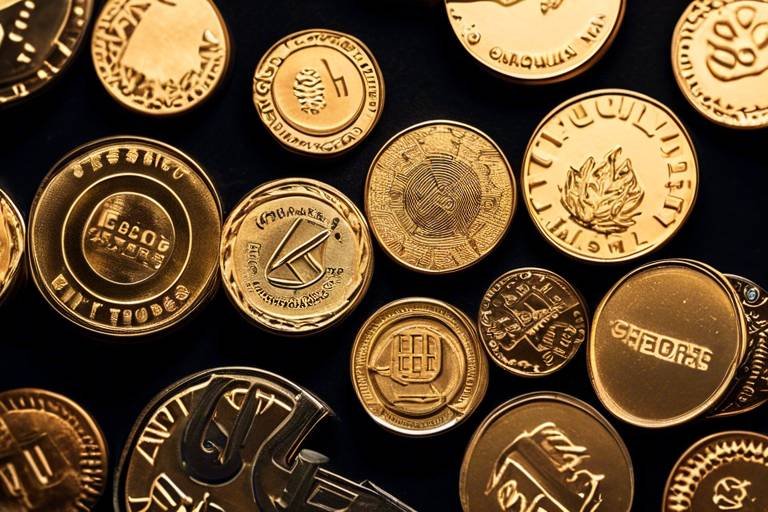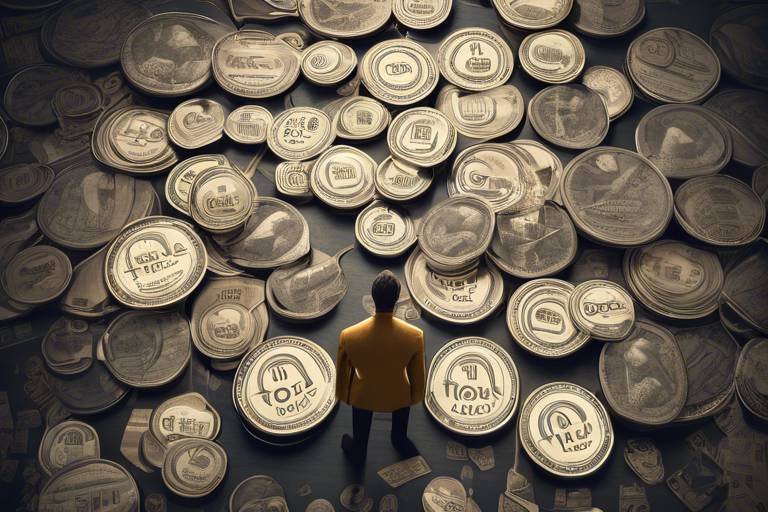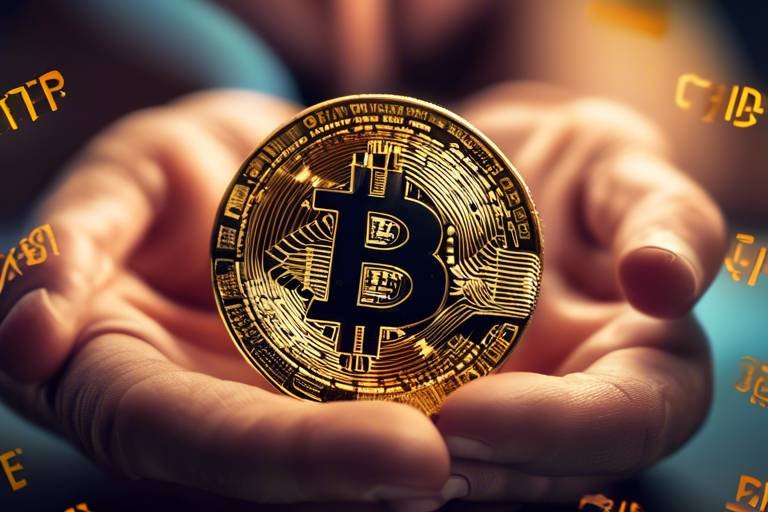Evaluating the Relationship Between Bitcoin and Gold Prices
In the ever-evolving landscape of investment, Bitcoin and gold have emerged as two of the most talked-about assets. While gold has been a traditional store of value for centuries, Bitcoin, often dubbed as "digital gold," has surged into the limelight over the past decade. This article explores the intricate relationship between these two assets, shedding light on their price movements, market sentiment, and the broader implications for investors. Understanding this relationship is not just a matter of curiosity; it can significantly influence investment strategies and decisions.
As we delve deeper into the historical price trends of Bitcoin and gold, it becomes evident that both assets exhibit unique yet interconnected behaviors. For instance, during periods of economic uncertainty, investors often flock to gold, viewing it as a safe haven. In contrast, Bitcoin's volatility can either attract risk-seeking investors or repel conservative ones, depending on the prevailing market conditions. By analyzing these trends, we can gain insights into how these assets might perform in the future, allowing investors to make informed decisions.
Moreover, market sentiment plays a crucial role in shaping the dynamics between Bitcoin and gold. Investor psychology can drive prices up or down, often leading to surprising market reactions. For example, during times of crisis, the collective mood can shift dramatically, causing a surge in demand for both gold and Bitcoin. This behavior reflects a broader trend where investors seek refuge in assets perceived as stable or valuable during turbulent times.
As we navigate through this article, we will also explore correlation studies that highlight the relationship between Bitcoin and gold prices. These studies reveal significant findings that can help investors understand the potential risks and rewards associated with each asset. Additionally, we will examine how economic indicators, such as inflation and interest rates, impact both Bitcoin and gold prices, further elucidating their relationship in the context of the broader economy.
Ultimately, the future outlook for Bitcoin and gold remains uncertain. With the financial landscape constantly changing, investors must stay informed and adaptable. By understanding the interplay between these two assets, we can better navigate the complexities of investing in today's market. So, whether you're a seasoned investor or just starting out, this exploration of Bitcoin and gold will equip you with the knowledge needed to make strategic investment choices.
- What is the primary difference between Bitcoin and gold? Bitcoin is a digital currency that operates on a decentralized network, while gold is a physical asset that has been used as a store of value for centuries.
- Can Bitcoin replace gold as a safe haven asset? While some investors view Bitcoin as a potential replacement for gold, its volatility and regulatory uncertainties make it a riskier option.
- How do inflation rates affect Bitcoin and gold prices? Generally, rising inflation leads investors to seek out gold and Bitcoin as hedges against currency devaluation, often driving their prices up.
- What factors influence the correlation between Bitcoin and gold? Economic indicators, market sentiment, and global events can all impact the relationship between Bitcoin and gold prices.

Historical Price Trends
When we dive into the historical price movements of Bitcoin and gold, it’s like opening a treasure chest of insights. Both assets have experienced their fair share of ups and downs, but understanding these trends can provide valuable clues for investors looking to navigate the complex waters of the financial market. Over the past decade, Bitcoin has transformed from a niche digital currency into a significant player in the investment world, while gold has maintained its status as a traditional safe haven. So, what does the data tell us?
To illustrate the relationship between these two assets, let's take a look at a few key price milestones:
| Year | Bitcoin Price (USD) | Gold Price (USD) |
|---|---|---|
| 2011 | $31 | $1,570 |
| 2013 | $1,200 | $1,400 |
| 2017 | $19,783 | $1,300 |
| 2020 | $28,949 | $1,900 |
| 2023 | $40,000 | $2,000 |
From this table, it’s clear that Bitcoin has experienced exponential growth, especially in 2017 and 2020, while gold has steadily increased, reflecting its role as a stable asset. The contrast in their price trajectories highlights an intriguing dynamic. While Bitcoin's volatility can be thrilling, gold’s steadiness offers a sense of security. This brings us to an important question: how do these price trends affect investor behavior?
As we analyze these historical trends, we can see that during times of economic uncertainty, both Bitcoin and gold tend to attract more attention. For instance, during the COVID-19 pandemic, many investors flocked to these assets as a hedge against market instability. This phenomenon raises an interesting point: while Bitcoin is often touted as "digital gold," it also carries a different risk profile. Investors need to weigh the potential for high returns against the volatility that Bitcoin presents.
In summary, the historical price trends of Bitcoin and gold reveal a complex relationship that is influenced by various factors, including market sentiment, economic conditions, and investor behavior. As we move forward, understanding these trends will be crucial for anyone looking to invest in these two assets. Are you ready to explore how market sentiment plays into this relationship?

Market Sentiment Analysis
Understanding market sentiment is crucial for evaluating the relationship between Bitcoin and gold. The emotions and attitudes of investors can significantly influence asset prices, often leading to dramatic shifts in market dynamics. When we talk about market sentiment, we're diving into the psychology of investors—how they feel about the market and what drives their decisions. This sentiment can be swayed by various factors, including economic news, geopolitical events, and even social media trends. For instance, a tweet from a high-profile individual can send Bitcoin prices soaring or crashing in mere moments, showcasing just how volatile and reactive this market can be.
During periods of economic uncertainty, investor sentiment tends to shift. Many investors flock to traditional safe-haven assets like gold, while a growing number are turning to Bitcoin, viewing it as a modern alternative. This duality in perception raises an interesting question: Are these two assets competing for the same investor attention, or do they serve different purposes in a diversified portfolio? To answer this, we need to delve deeper into how sentiment manifests in both markets.
One of the most fascinating aspects of market sentiment is the way it can create feedback loops. As more investors buy into gold during a crisis, the price increases, which in turn attracts even more buyers. Similarly, when Bitcoin experiences a surge in popularity, it creates a buzz that can lead to increased interest from new investors. This can create a cycle where sentiment drives prices, and rising prices further boost sentiment.
To illustrate this relationship, let’s look at some key factors that influence market sentiment:
- Economic Indicators: Reports on inflation, unemployment, and GDP growth can sway investor confidence.
- Geopolitical Events: Tensions in global politics often lead to increased investment in gold, as it is seen as a stable asset.
- Technological Developments: Innovations in blockchain technology can enhance Bitcoin’s appeal, attracting tech-savvy investors.
In the context of financial crises, the behavior of investors can vary dramatically. Historically, gold has been the go-to asset during downturns, but Bitcoin's emergence as a viable alternative has changed the landscape. The perception of Bitcoin as 'digital gold' has gained traction, especially among younger investors who are more inclined to embrace technology. This shift in sentiment is not just a passing trend; it reflects a broader change in how we view value and security in the modern financial landscape.
Moreover, the psychological factors at play cannot be ignored. Fear, greed, and the desire for quick returns can lead to irrational decision-making. During times of market volatility, investors may react impulsively, leading to sharp price fluctuations in both Bitcoin and gold. Understanding these psychological elements is essential for investors looking to navigate the turbulent waters of these markets.
In conclusion, market sentiment plays a pivotal role in the relationship between Bitcoin and gold. As we continue to observe shifts in investor behavior and sentiment, it becomes increasingly clear that both assets will likely coexist, catering to different investor needs and preferences. The question remains: how will future economic conditions shape this sentiment, and what will it mean for the prices of these two assets?
- What is market sentiment? Market sentiment refers to the overall attitude of investors toward a particular security or financial market. It can be influenced by various factors, including news, events, and market trends.
- How does market sentiment affect Bitcoin and gold prices? Positive sentiment can drive prices up, while negative sentiment can lead to declines. Both assets are influenced by investor psychology and external events.
- Is Bitcoin a safe haven like gold? While gold has a long-standing reputation as a safe haven, Bitcoin is increasingly viewed as a digital alternative, particularly among younger investors.

Investor Behavior During Crises
When financial crises hit, the landscape of investment changes dramatically, often resembling a battlefield where every decision carries weight. Investors, much like soldiers, scramble to find their safest haven amidst chaos. During these tumultuous times, the behavior of investors tends to shift significantly, leading to a heightened interest in assets like gold and Bitcoin. But why do these assets attract so much attention when the going gets tough?
Historically, gold has been the go-to asset for those seeking refuge during economic downturns. Its intrinsic value and universal acceptance make it a reliable choice. Investors flock to gold for several reasons:
- Store of Value: Gold has maintained its purchasing power over centuries, making it a trusted asset.
- Inflation Hedge: During inflationary periods, gold often retains its value better than fiat currencies.
- Market Liquidity: Gold can be easily bought and sold, providing quick access to cash when needed.
On the other hand, Bitcoin's emergence as a digital gold has changed the game. While it may not have the long-standing history that gold boasts, its appeal has surged in recent years, especially during crises. Investors are increasingly viewing Bitcoin as a modern solution to traditional problems. Here are a few reasons why Bitcoin is gaining traction:
- Decentralization: Unlike traditional currencies, Bitcoin operates on a decentralized network, making it less susceptible to government interference.
- Limited Supply: With a capped supply of 21 million coins, Bitcoin offers scarcity, which can drive its value up during times of uncertainty.
- Global Accessibility: Bitcoin can be accessed and traded from anywhere in the world, breaking down barriers that traditional assets may have.
As we navigate through economic uncertainties, the correlation between gold and Bitcoin becomes particularly fascinating. For instance, during the COVID-19 pandemic, both assets saw significant price surges, indicating that investors were seeking safe havens simultaneously. This phenomenon raises a critical question: Are Bitcoin and gold competitors, or can they coexist as complementary assets in an investor's portfolio?
Moreover, the psychological aspect of investing during crises cannot be overlooked. Fear and uncertainty can lead to herd behavior, where investors rush to buy gold and Bitcoin, driving prices up even further. This reaction can create a feedback loop, where rising prices attract even more investors, perpetuating the cycle. Understanding this behavior is crucial for any investor looking to navigate the turbulent waters of financial crises.
In conclusion, the behavior of investors during crises highlights a significant shift in the perception of assets. While gold remains a stalwart safe haven, Bitcoin is carving out its niche as a viable alternative. As we look to the future, it will be interesting to see how these assets interact and influence each other in times of economic distress.
- Why do investors prefer gold during crises?
Gold is seen as a reliable store of value and a hedge against inflation, making it a safe choice during economic downturns. - Is Bitcoin a safe investment during financial crises?
While Bitcoin has shown resilience, its volatility can pose risks. However, many view it as a modern alternative to gold. - How do economic indicators affect gold and Bitcoin?
Economic indicators like inflation and interest rates can significantly influence the attractiveness of both assets.

Gold as a Traditional Safe Haven
Gold has long been recognized as a traditional safe haven during times of economic uncertainty. Its allure lies not just in its intrinsic value, but also in its historical significance as a store of wealth. Throughout centuries, gold has been a reliable asset that investors turn to when the financial markets are tumultuous. Unlike paper currencies that can be printed at will, gold is finite and cannot be manipulated in the same way. This scarcity is a key reason why it retains its value, even when other assets falter.
When we look at historical data, we see a clear pattern: during times of crisis, be it a recession, political instability, or global pandemics, gold prices tend to soar. Investors flock to gold, driving up its price in a bid to safeguard their wealth. For instance, during the 2008 financial crisis, gold prices skyrocketed as investors sought refuge from plummeting stock values. This behavior is often driven by a psychological response—when fear grips the market, gold shines even brighter.
Moreover, gold's role as a safe haven is not just anecdotal; it's backed by substantial evidence. A study conducted by the World Gold Council found that gold has a low correlation with other asset classes, making it an excellent diversifier in an investment portfolio. This means that when stocks are down, gold often holds its ground or even increases in value, providing a cushion for investors. In fact, many financial advisors recommend allocating a percentage of one’s portfolio to gold for this very reason.
As we navigate through the complexities of modern finance, the question arises: Is gold still the go-to safe haven in today's digital age? While traditionalists may argue that gold's value is timeless, the emergence of digital assets like Bitcoin has introduced a new dynamic to the conversation. Some investors now view Bitcoin as a modern safe haven, akin to gold. However, the volatility associated with Bitcoin means that it may not provide the same level of security that gold does during turbulent times.
In conclusion, while gold remains a cornerstone of wealth preservation, it’s essential to consider the evolving landscape of investment options. As investors weigh their choices, understanding the historical context and the psychological underpinnings of asset behavior during crises will be crucial in making informed decisions. Whether one chooses gold, Bitcoin, or a combination of both, the key takeaway is to maintain a diversified portfolio that can weather the storms of economic uncertainty.
- Why do investors consider gold a safe haven? Gold has a long history of retaining value during economic downturns, making it a reliable asset for wealth preservation.
- How does gold compare to Bitcoin as a safe haven? While both assets can serve as safe havens, gold is traditionally viewed as more stable, whereas Bitcoin is more volatile.
- What percentage of my portfolio should be in gold? Financial advisors typically recommend 5-10% of your portfolio be allocated to gold for diversification.
- How does inflation affect gold prices? Generally, inflation drives investors toward gold, as it is seen as a hedge against decreasing purchasing power.

Bitcoin's Emergence as Digital Gold
In recent years, Bitcoin has increasingly been referred to as "digital gold," and for good reason. Just like gold, Bitcoin has established itself as a valuable asset that can act as a hedge against inflation and economic instability. But what exactly does this comparison mean for investors? To understand this phenomenon, we need to delve into the characteristics that make Bitcoin similar to gold.
First and foremost, both assets share a limited supply. Gold is a finite resource, and its extraction becomes more challenging over time, which inherently increases its value. Similarly, Bitcoin has a capped supply of 21 million coins, a feature built into its code. This scarcity is a fundamental aspect that drives demand, making it appealing to investors looking for assets that can withstand economic fluctuations.
Moreover, Bitcoin has gained traction as a store of value. Investors are increasingly turning to Bitcoin during times of market volatility. This behavior mirrors that of gold, which has long been regarded as a safe haven. For instance, during the COVID-19 pandemic, many investors flocked to both gold and Bitcoin, viewing them as secure options amidst the chaos. The correlation between the two assets during this period reinforced Bitcoin's status as a digital counterpart to gold.
Another critical factor contributing to Bitcoin's emergence as digital gold is its growing acceptance among institutional investors. Over the past few years, major financial institutions have begun to allocate portions of their portfolios to Bitcoin, recognizing its potential as a long-term investment. This institutional interest has not only enhanced Bitcoin's legitimacy but has also led to increased liquidity in the market, making it more attractive to everyday investors.
However, it’s essential to recognize the differences between Bitcoin and gold. While gold has a long-standing history as a reliable asset, Bitcoin is still relatively new. This novelty means that Bitcoin can be more volatile, which might deter conservative investors. But for those willing to embrace the risks, the potential rewards can be significant. The following table summarizes some of the key similarities and differences between Bitcoin and gold:
| Feature | Bitcoin | Gold |
|---|---|---|
| Supply | Limited to 21 million coins | Finite resource, harder to mine over time |
| Volatility | High | Generally stable |
| Historical Use | New (since 2009) | Ancient (thousands of years) |
| Institutional Adoption | Increasing | Established |
In conclusion, the emergence of Bitcoin as digital gold is a fascinating development in the world of finance. While it shares many characteristics with traditional gold, its unique traits and the rapidly changing market dynamics make it an exciting asset for investors. As the landscape continues to evolve, the relationship between Bitcoin and gold will undoubtedly be a topic of interest for years to come.
- Is Bitcoin a safer investment than gold? While Bitcoin has potential for high returns, it is also more volatile than gold. Investors should consider their risk tolerance before investing.
- Can Bitcoin replace gold? While Bitcoin is emerging as a digital alternative to gold, it is unlikely to completely replace gold due to gold's long-standing historical significance.
- What factors influence Bitcoin's price? Bitcoin's price is influenced by supply and demand, market sentiment, regulatory news, and macroeconomic trends.

digital gold.
This article explores the correlation between Bitcoin and gold prices, analyzing market trends, investor behavior, and the implications for future investments in these two assets.
Examining the historical price movements of Bitcoin and gold reveals patterns that can inform investors about potential future behavior and market dynamics between these two assets.
Understanding market sentiment is crucial for evaluating the relationship between Bitcoin and gold. This section delves into investor psychology and its impact on asset prices during various economic conditions.
This subheading focuses on how investor behavior shifts during financial crises, often leading to increased interest in gold and Bitcoin as safe-haven assets.
Gold has historically been viewed as a safe haven during economic uncertainty. This section discusses its role and how it compares to Bitcoin in similar scenarios.
Bitcoin is often referred to as digital gold. This comparison stems from several key factors that have positioned Bitcoin as a modern alternative to traditional gold investments. Just as gold has been a store of value for centuries, Bitcoin has emerged in the 21st century as a digital asset that many investors view as a hedge against economic instability and inflation. The idea of Bitcoin as digital gold is not just a catchy phrase; it reflects a significant shift in how we perceive value in a rapidly evolving financial landscape.
One of the primary reasons for this perception is Bitcoin's limited supply. Just like gold, which is finite and requires significant resources to mine, Bitcoin is capped at 21 million coins. This scarcity creates a sense of value and a safeguard against inflation, making it an attractive option for investors looking for stability in turbulent times. Moreover, as traditional currencies lose purchasing power due to inflation, both gold and Bitcoin serve as alternatives that can potentially retain or even increase value.
Additionally, Bitcoin has gained traction as a decentralized asset. Unlike gold, which is often subject to geopolitical tensions and regulatory pressures, Bitcoin operates on a blockchain network that is not controlled by any single entity. This decentralization offers a level of security and autonomy that appeals to a growing number of investors who are wary of traditional financial systems.
However, the comparison between Bitcoin and gold is not without its complexities. While Bitcoin can be seen as a digital version of gold, its price volatility is significantly higher. This volatility can be both a blessing and a curse. On one hand, it presents opportunities for high returns; on the other, it poses risks that traditional gold investors might not be accustomed to. Investors must weigh these factors carefully when considering their portfolios.
In conclusion, the emergence of Bitcoin as digital gold represents a fascinating evolution in the investment landscape. As more people recognize the potential of Bitcoin to serve as a store of value and a hedge against economic uncertainty, its role alongside gold will continue to be a topic of significant discussion among investors and financial analysts alike.
This section presents various studies that analyze the correlation between Bitcoin and gold prices, highlighting significant findings and their relevance to investors.
Economic indicators, such as inflation and interest rates, significantly affect both Bitcoin and gold prices. This section investigates how these indicators influence investor decisions and market movements.
Inflation tends to drive investors toward gold and Bitcoin as hedges. This subheading examines the relationship between inflation rates and the performance of these two assets.
Interest rates play a pivotal role in shaping investment strategies. This section discusses how changes in interest rates can impact the attractiveness of Bitcoin versus gold.
The future relationship between Bitcoin and gold remains uncertain. This section speculates on potential trends and advises investors on how to navigate the evolving landscape of these assets.
- What is the main reason Bitcoin is considered digital gold?
Bitcoin is considered digital gold primarily due to its limited supply and its role as a hedge against inflation, similar to traditional gold. - How do Bitcoin and gold prices correlate?
While both assets can serve as safe havens, their correlation can fluctuate based on market conditions, investor sentiment, and economic indicators. - Is Bitcoin a safer investment than gold?
Bitcoin is generally more volatile than gold, making it riskier. However, it also offers the potential for higher returns, depending on market dynamics.

This subheading explores the factors contributing to this perception and its implications for investor choices.
In recent years, Bitcoin has increasingly been referred to as digital gold, a term that encapsulates its growing status as a store of value akin to traditional gold. But what exactly contributes to this perception? And how does it affect investor choices? Let's dive into this fascinating topic.
First off, one of the primary factors that has led to Bitcoin being labeled as digital gold is its scarcity. Bitcoin operates on a fixed supply model, capped at 21 million coins. This limited supply mirrors gold's finite nature, where extraction becomes more challenging over time. Just as investors flock to gold in times of uncertainty due to its scarcity, many are now turning to Bitcoin for the same reason. This perception of scarcity can create a sense of urgency among investors, leading them to view Bitcoin as a hedge against inflation and currency devaluation.
Another crucial factor is the decentralization of Bitcoin. Unlike gold, which is subject to fluctuations in mining operations and geopolitical tensions, Bitcoin operates on a decentralized network that is not controlled by any single entity. This autonomy appeals to investors who are wary of traditional financial systems and the potential for government intervention. The idea of owning a digital asset that is not tethered to any central authority resonates with those who seek financial independence and security.
Furthermore, the technological advancements surrounding Bitcoin have significantly influenced its perception as digital gold. The rise of blockchain technology not only enhances Bitcoin's security but also provides transparency in transactions. Investors appreciate the ability to track their assets without the need for intermediaries, making Bitcoin a more attractive option for those who value innovation and efficiency.
Moreover, the growing acceptance of Bitcoin by institutional investors has further solidified its status as digital gold. Major financial institutions and corporations are beginning to allocate a portion of their portfolios to Bitcoin, viewing it as a legitimate asset class. This institutional backing lends credibility to Bitcoin and encourages retail investors to consider it as a viable alternative to gold.
However, it’s crucial to recognize that the implications of Bitcoin being viewed as digital gold extend beyond mere perception. For investors, this means they must navigate a complex landscape of market dynamics and investor sentiment. As more individuals and institutions adopt Bitcoin, its price can become increasingly volatile, influenced by speculation and market trends. This volatility can create both opportunities and risks for investors, making it essential to stay informed and adaptable.
In conclusion, the perception of Bitcoin as digital gold is shaped by several interrelated factors, including its scarcity, decentralization, technological advancements, and institutional acceptance. As investors weigh their options, understanding these elements becomes crucial in making informed decisions. The landscape of investment continues to evolve, and for those looking to diversify their portfolios, recognizing the implications of Bitcoin's emergence as digital gold is key.
- Why is Bitcoin considered a safe haven asset? Bitcoin is viewed as a safe haven due to its limited supply and decentralized nature, similar to gold.
- How does Bitcoin's volatility compare to gold? Bitcoin tends to be more volatile than gold, which can present both risks and opportunities for investors.
- Can Bitcoin replace gold? While Bitcoin is gaining traction, many investors still see gold as a traditional safe haven, making it unlikely for Bitcoin to completely replace it.
- What are the risks of investing in Bitcoin? The risks include market volatility, regulatory changes, and potential security breaches.

Correlation Studies
When it comes to understanding the relationship between Bitcoin and gold, play a crucial role. These studies analyze historical price movements to identify patterns that can inform investors about how these two assets behave relative to one another. For instance, during periods of economic uncertainty, one might expect these assets to move in tandem, as investors flock to safe havens. However, the reality can be more complex.
Research has shown that the correlation between Bitcoin and gold can fluctuate significantly over time. For example, a study conducted by Coin Metrics highlighted that the correlation coefficient between Bitcoin and gold was relatively low during certain periods, suggesting that they do not always react similarly to market changes. This is particularly interesting when you consider that both assets are often touted as hedges against inflation and economic instability.
To illustrate this point, let's take a look at some key findings from various studies:
| Study | Correlation Coefficient | Time Period |
|---|---|---|
| Coin Metrics Study | 0.2 | 2018-2020 |
| Cryptocurrency Research Group | 0.5 | 2020-2021 |
| Market Trends Analysis | 0.7 | 2021-2023 |
As shown in the table, the correlation coefficient has varied from a mere 0.2 to as high as 0.7 in different time frames. A coefficient closer to 1 indicates a strong positive correlation, meaning that when one asset rises, the other tends to rise as well. Conversely, a low coefficient suggests that the assets may behave independently of each other. This variability can be attributed to several factors, including market sentiment, economic conditions, and the evolving nature of both assets.
Moreover, the perception of Bitcoin as "digital gold" has led to increased interest in its correlation with gold. Investors often look for patterns that might suggest a similar safe-haven status. However, it's essential to remember that Bitcoin is still a relatively new asset compared to gold, which has been a store of value for thousands of years. Therefore, while some studies suggest a growing correlation, it’s vital to approach these findings with caution.
In conclusion, correlation studies provide valuable insights into the relationship between Bitcoin and gold. They reveal that while there can be periods of significant correlation, the relationship is not static and can change based on a myriad of factors. Investors should remain vigilant and consider these fluctuations when making investment decisions.
- What is the main takeaway from correlation studies between Bitcoin and gold?
Correlation studies reveal that the relationship between Bitcoin and gold can vary significantly over time, influenced by market conditions and investor behavior. - How can investors use correlation studies?
Investors can use correlation studies to gauge potential risks and rewards, helping them make informed decisions about diversifying their portfolios between Bitcoin and gold. - Is Bitcoin a reliable hedge against inflation like gold?
While both assets are often viewed as hedges against inflation, Bitcoin's relatively short history means its long-term reliability as a hedge compared to gold remains uncertain.

Impact of Economic Indicators
The relationship between economic indicators and asset prices is a fascinating area of study, particularly when it comes to Bitcoin and gold. These two assets often react differently to various economic conditions, influenced by factors like inflation and interest rates. Understanding how these indicators affect market behavior can provide investors with critical insights into when to buy or sell. It’s like having a weather forecast for your investments—knowing when to bring an umbrella or when to put on sunscreen can make all the difference!
Inflation, for instance, has traditionally been a significant driver of demand for both gold and Bitcoin. As inflation rises, the purchasing power of fiat currencies declines, leading investors to seek out assets that can preserve their wealth. This is where gold shines as a historical safe haven. But what about Bitcoin? Many have begun to view it as a digital alternative to gold, often referred to as "digital gold." This perception is gaining traction as Bitcoin’s supply is capped, which theoretically protects it against inflationary pressures.
To illustrate this relationship, let’s take a look at a simplified table depicting the correlation between inflation rates and the performance of Bitcoin and gold over the past few years:
| Year | Inflation Rate (%) | Gold Price ($/oz) | Bitcoin Price ($) |
|---|---|---|---|
| 2020 | 1.2 | 1,890 | 29,000 |
| 2021 | 7.0 | 1,800 | 60,000 |
| 2022 | 8.0 | 1,750 | 19,000 |
From the table, you can see that as inflation rates spiked in 2021 and 2022, both gold and Bitcoin experienced significant price fluctuations. While gold maintained a more stable price trajectory, Bitcoin's volatility became evident, showcasing the speculative nature of cryptocurrency investments. This leads us to another crucial economic indicator: interest rates.
Interest rates play a pivotal role in shaping investment choices. When rates are low, borrowing costs decrease, leading to increased spending and investment in riskier assets, including Bitcoin. Conversely, when interest rates rise, the cost of borrowing increases, making traditional investments like bonds more attractive compared to volatile assets like Bitcoin. This dynamic can create a tug-of-war between risk appetite and safety, influencing how investors allocate their portfolios.
In conclusion, the impact of economic indicators on Bitcoin and gold prices is multifaceted and complex. Investors must stay informed about inflation trends and interest rate changes to navigate the often turbulent waters of these assets effectively. It's like being a captain navigating through stormy seas—knowing when to steer your ship towards the safety of the harbor or when to ride the waves can determine your success in the investment world.
- How does inflation affect gold prices? Inflation generally drives up gold prices as investors seek to preserve their purchasing power.
- Is Bitcoin a good hedge against inflation? Many investors view Bitcoin as a hedge against inflation due to its capped supply, but its volatility can present risks.
- How do interest rates influence Bitcoin and gold? Low interest rates may encourage investment in Bitcoin, while high rates typically favor traditional assets like gold and bonds.

Inflation and Asset Prices
When it comes to investing, one of the most critical factors to consider is inflation. It’s that sneaky little monster that eats away at your purchasing power, making everything more expensive over time. Both Bitcoin and gold have emerged as popular choices for investors looking to hedge against this economic threat. But how exactly does inflation influence the prices of these two assets? Let’s dive into the details!
Historically, inflation has a profound impact on investor behavior. When inflation rates rise, the value of traditional currency tends to decline, prompting investors to seek refuge in assets that can retain value. This is where gold shines. For centuries, gold has been the go-to asset during inflationary periods. Investors flock to it, driving up its price as they attempt to safeguard their wealth. The increased demand for gold during inflation can be illustrated through the following table:
| Year | Inflation Rate (%) | Gold Price ($/oz) |
|---|---|---|
| 2008 | 3.84 | 869.75 |
| 2011 | 3.16 | 1571.52 |
| 2020 | 1.23 | 1895.10 |
| 2021 | 7.00 | 1800.00 |
As you can see from the table, there’s often a correlation between rising inflation rates and increasing gold prices. But what about Bitcoin? While it’s a relatively new player in the game, Bitcoin is increasingly being viewed as “digital gold.” Many investors believe it can serve a similar purpose in protecting against inflation. Bitcoin’s limited supply—capped at 21 million coins—creates a sense of scarcity that appeals to those worried about inflation eroding their wealth.
Interestingly, the relationship between Bitcoin and inflation is still being tested. Some studies suggest that Bitcoin can act as a hedge against inflation, while others argue that its price volatility makes it a risky choice. This uncertainty leads to a mix of investor sentiment. Some are all-in on Bitcoin as a future store of value, while others remain skeptical.
In times of high inflation, investors must weigh their options carefully. Here are a few key considerations:
- Historical Performance: Look at how both assets have performed during previous inflationary periods.
- Market Sentiment: Gauge the overall mood of the market. Are investors flocking to Bitcoin or gold?
- Risk Tolerance: Consider your own comfort level with risk. Bitcoin’s volatility can be thrilling but also nerve-wracking.
As we move forward, the interplay between inflation rates and asset prices will continue to shape investment strategies. Whether you choose gold, Bitcoin, or a mix of both, being informed about how inflation affects these assets is crucial. After all, in the world of investing, knowledge is power!
In conclusion, while both Bitcoin and gold serve as potential hedges against inflation, they come with their unique sets of risks and rewards. As an investor, it’s essential to stay informed and adaptable, ensuring that your investment strategy aligns with your financial goals and the ever-changing economic landscape.

Interest Rates and Investment Choices
Interest rates are like the heartbeat of the economy; they pulse through financial markets, influencing everything from consumer spending to investment choices. When central banks adjust interest rates, they send ripples across asset classes, including Bitcoin and gold. But how do these changes affect investors' preferences between these two popular assets? Let’s dive into the details!
When interest rates are low, borrowing becomes cheaper, and investors often seek higher returns in riskier assets. This scenario can lead to increased interest in cryptocurrencies like Bitcoin, as many view it as an opportunity for high returns. Conversely, when interest rates rise, the allure of safer investments, such as gold, becomes more appealing. Investors may flock to gold as a hedge against economic uncertainty, especially if they believe that rising rates could lead to a downturn in the stock market.
To illustrate this dynamic, consider the following table that summarizes how different interest rate environments can influence investor behavior:
| Interest Rate Environment | Investor Behavior | Preference Between Assets |
|---|---|---|
| Low Interest Rates | Increased borrowing, higher risk tolerance | Favor Bitcoin for potential high returns |
| Moderate Interest Rates | Balanced approach to risk | Equal interest in both Bitcoin and gold |
| High Interest Rates | Conservative spending, focus on safety | Favor gold as a safe haven |
It's fascinating to see how these preferences shift based on the economic climate. For instance, during times of economic expansion, when interest rates are typically lower, investors might be more inclined to explore Bitcoin as a speculative asset. However, in periods of economic contraction, when rates rise to combat inflation, gold often shines as a protective asset. This behavior reflects a fundamental principle of investing: when the going gets tough, investors tend to gravitate towards safety.
Moreover, the relationship between interest rates and asset prices can also be influenced by inflation expectations. If investors anticipate that inflation will rise, they may turn to both gold and Bitcoin as hedges against the eroding purchasing power of their cash holdings. This is particularly relevant in today’s economic environment, where inflation fears loom large, making both assets attractive in different ways.
In summary, understanding the interplay between interest rates and investment choices is crucial for anyone looking to navigate the complex landscape of Bitcoin and gold. As these economic indicators fluctuate, so too will the preferences of investors, creating a dynamic environment where both assets can play vital roles in a diversified portfolio.
- How do interest rates affect Bitcoin prices? Low interest rates can lead to increased investment in Bitcoin as a speculative asset, while high rates may drive investors to safer assets like gold.
- Is gold still a good investment in a low-interest-rate environment? Yes, gold can still be a good investment as it is often seen as a hedge against inflation, even when interest rates are low.
- Can Bitcoin replace gold as a safe haven? While Bitcoin is often referred to as "digital gold," its volatility makes it less stable than gold, which has a long-standing reputation as a safe haven.

Future Outlook
The future relationship between Bitcoin and gold is a topic that stirs much debate among investors and analysts alike. As we look ahead, several factors will likely shape the dynamics between these two assets. First off, the increasing adoption of Bitcoin as a legitimate investment vehicle could lead to a greater correlation with gold prices. With more institutional investors entering the cryptocurrency market, the perception of Bitcoin is evolving from a speculative asset to a more stable store of value, akin to gold.
On the other hand, traditional economic factors like inflation and interest rates will continue to play a significant role in determining the attractiveness of both assets. For instance, if inflation rates remain high, we can expect both Bitcoin and gold to attract more investors seeking to hedge against currency devaluation. This could result in a simultaneous rise in prices, reinforcing the idea that they are both considered safe havens during economic turmoil.
Moreover, the ongoing development of blockchain technology and the regulatory landscape surrounding cryptocurrencies will also influence Bitcoin's future. As governments around the world begin to implement clearer regulations, we may see a surge in confidence among investors, leading to increased demand for Bitcoin. This, in turn, could impact its relationship with gold, as more investors may compare the two as viable alternatives for diversifying their portfolios.
It’s also essential to consider the psychological aspect of investing. As more people become aware of Bitcoin's potential and start viewing it as "digital gold," we may see a shift in market sentiment. Investors often flock to assets that are perceived as trendy or innovative, which could mean that Bitcoin's price might surge, even if gold remains stable. This could create an interesting scenario where Bitcoin and gold exhibit a less predictable relationship.
In conclusion, while the future of Bitcoin and gold is uncertain, the interplay between these two assets will be shaped by a myriad of factors, including market sentiment, economic indicators, and technological advancements. Investors should remain vigilant and adaptable, keeping an eye on how these elements evolve. The key takeaway? Diversification remains crucial in navigating the ever-changing landscape of asset investments.
- What drives the price of Bitcoin and gold? Both assets are influenced by market demand, economic indicators, and investor sentiment. They often serve as hedges against inflation and economic instability.
- Is Bitcoin a better investment than gold? This depends on individual investment goals and risk tolerance. Bitcoin offers high volatility and potential for significant returns, while gold is a more stable, traditional asset.
- How do interest rates affect Bitcoin and gold? Generally, rising interest rates can make gold less attractive as it doesn't yield interest. Conversely, Bitcoin may benefit from increased institutional adoption despite rising rates.
- Can Bitcoin and gold coexist in a portfolio? Absolutely! Many investors choose to include both assets to balance risk and return, leveraging the unique benefits of each.
Frequently Asked Questions
- What is the relationship between Bitcoin and gold prices?
The relationship between Bitcoin and gold prices is often discussed in terms of their roles as investment assets. Both are viewed as potential hedges against inflation and market volatility, but their price movements can vary significantly based on market sentiment and economic conditions.
- How do historical price trends of Bitcoin and gold compare?
Historical price trends show that while Bitcoin can experience extreme volatility, gold tends to have more stable price movements. Analyzing these trends helps investors understand potential future behaviors and market dynamics between these two assets.
- Why do investors consider gold a safe haven?
Gold has been regarded as a safe haven for centuries, especially during economic downturns. Its intrinsic value and limited supply make it a reliable store of wealth when other investments falter, providing a sense of security for investors.
- What factors contribute to Bitcoin being seen as 'digital gold'?
Bitcoin is often referred to as 'digital gold' due to its scarcity and decentralized nature. Just like gold, Bitcoin has a capped supply, which can make it an attractive option for investors looking for a hedge against inflation and currency devaluation.
- How do economic indicators affect Bitcoin and gold prices?
Eeconomic indicators such as inflation and interest rates significantly influence the prices of both Bitcoin and gold. For instance, rising inflation typically drives investors toward these assets as safe havens, while changes in interest rates can shift investment preferences between them.
- What role does investor behavior play during financial crises?
During financial crises, investor behavior often shifts towards seeking safe-haven assets like gold and Bitcoin. This shift can lead to increased demand and price surges for these assets as investors look to protect their wealth amidst uncertainty.
- What is the future outlook for Bitcoin and gold?
The future relationship between Bitcoin and gold is uncertain, with potential trends influenced by market developments, regulatory changes, and investor sentiment. Staying informed and adaptable is crucial for navigating the evolving landscape of these assets.



















